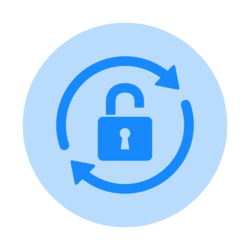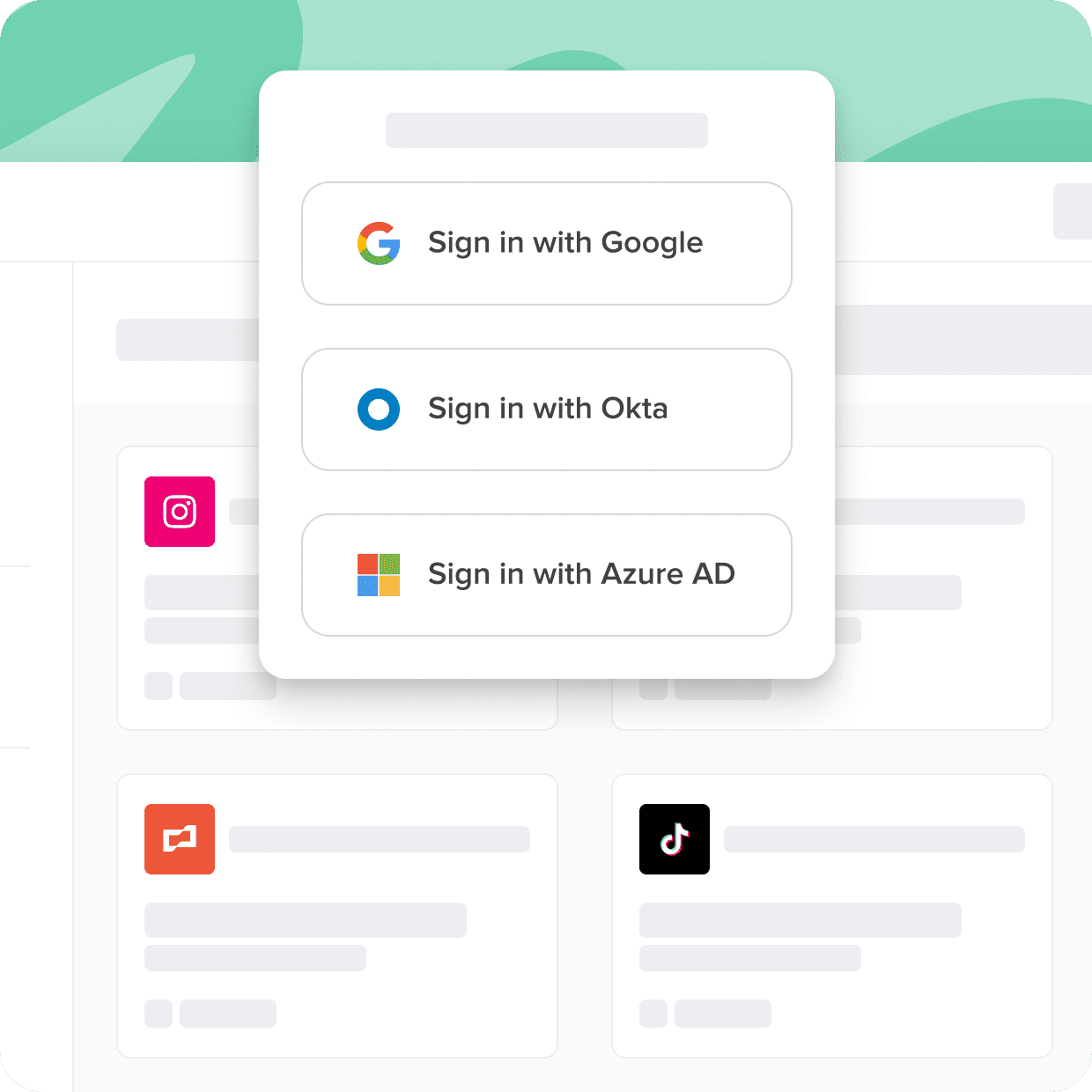Single sign-on (SSO) software is a fantastic technology allowing businesses to eliminate password reuse and simplify the login process. Unfortunately, many corporate applications don't support the SSO standard and can't reap all the benefits. The applications that fall into this category are best called "nonfederated." Nonfederated applications are a new category that is becoming increasingly challenging for businesses to manage and secure effectively, yet increasingly critical for businesses to succeed.
Cerby connects all of your apps to your SSO tools, even if they don't support the SSO standard. In this guide, you'll learn about SSO software, the history, and the benefits.
Streamline Access With Single Sign-on
Not all apps are created equal. Some come with security gaps and complexities that can hinder user adoption and put sensitive data at risk. With Cerby, you can ensure secure and seamless access to all your applications, regardless of their support for standards like SSO.
With Cerby You can

Close the identity gap

Universally enforce 2FA

Eliminate the SSO tax
Single Sign-On Software
Single sign-on (SSO) is a unique access control system that permits end users to authenticate safely with multiple websites and applications using just one set of login credentials. This technology has become vital for businesses over the past few years, becoming an integral part of the digital landscape.
Single sign-on software has its roots in the late 1960s when computer networks grew prevalent and there was a need for secure user access that went beyond basic authentication. The first commercial implementation was developed by Compatible Systems Corporation, followed by several other companies, including:
- Microsoft
- Novell
- Sun Microsystems
- Oracle
Today SSO is used across many industries, from government agencies to large corporations, and has become integral in providing secure access and authentication to users. This technology allows users to bypass the traditional multiple login process, which requires them to remember different sets of credentials and passwords for each application they use. With SSO, a single user account can be used to log into all their applications, saving time and effort and improving security by eliminating the need for maintaining separate identities.
In addition, SSO solutions allow organizations to take advantage of centralized user management systems and ensure consistent access control across all applications. This helps reduce complexity in IT system administration so that users’ accounts stay up-to-date with the latest security measures.
Single Sign-On Solutions
Single sign-on solutions are becoming the go-to authentication method for businesses of all sizes. With SSO, users only need to enter one set of credentials, like a username and password, to access multiple applications or services. This makes logging into different systems much simpler and lowers your risk of being locked out due to forgotten usernames or passwords. By streamlining this process with single sign-on solutions, companies can easily keep their accounts secure while ensuring their employees have easy access when needed.
Employing single sign-on methods offers organizations many benefits. It offers enhanced security and cost savings, allowing businesses greater control over user access rights, improved compliance with industry regulations and standards, data protection optimization, and an effortless authentication process. Furthermore, deploying an SSO solution reduces the IT overhead costs associated with managing multiple accounts and passwords.
SSO solutions can be categorized into two types: third-party SSO and enterprise-level SSO. Third-party SSO involves an external service provider that handles user credentials, while the more complex enterprise-level SSO is set up within a business’s internal processes and networks.
Organizations can enhance their security with various single sign-on methods, including:
- Two-factor authentication (2FA)
- One-time passwords (OTPs)
- SMS/email challenges
- Biometric identification
Additionally, they can also deploy a single sign-on portal to manage users’ access rights across various applications or services within the system.
To explore some unique and innovative use cases of single sign-on software, consider the following single sign-on examples:
-
Automated retail environments: For businesses such as retail stores and supermarkets, SSO solutions allow customers to quickly check out without needing to remember multiple usernames and passwords. This improves customer experience by eliminating time spent waiting in queues or entering login credentials.
-
Healthcare institutions: In healthcare institutions, SSO solutions are used to manage patient records securely and conveniently. By using a single sign-on system, healthcare workers can access patient data with their own authorized credentials, reducing manual work associated with tracking multiple accounts for various applications within the system
-
Financial services organizations: Banks and other financial services organizations recognize the importance of security when it comes to customer data. To ensure a safe, secure experience for their customers, these entities rely heavily on SSO solutions, an efficient way to authenticate customers and allow account access in seconds
SSO Provider Open Source
Open-source single sign-on (SSO) solutions have grown substantially in popularity over the past few years and for good reason. This kind of software allows users to gain access to multiple services with ease, all while keeping them secure. Best of all, businesses of any size can take advantage. Open-source SSO is free and easy to use, creating an ideal security plan for organizations regardless of their circumstances.
Advantages of open-source SSO
The advantages of open-source SSO are many. For starters, no licensing fees are associated with using open-source software. Furthermore, developers can review and modify the open code to tailor it specifically to their needs. With open-source solutions comes unparalleled flexibility, as organizations are able to leverage the power of open-source technology and create custom SSO solutions that best meet their needs.
Popular open-source SSO projects
When it comes to popular open-source SSO projects, there are a few well-known contenders. Security Assertion Markup Language (SAML) is an XML-based framework that enables organizations to share authentication data between different services easily and securely. It is an open standard used by many large companies and governments around the world.
Additionally, Keycloak is a popular open-source identity and access management (IAM) solution that allows organizations to secure their web services with the help of single sign-on technology.
In conclusion, the best open-source SSO solutions have become increasingly popular due to the advantages they offer. With no licensing fees and unparalleled flexibility, organizations of all sizes can benefit from leveraging these solutions for secure authentication and access control. Additionally, a few popular projects, such as open-source SAML SSO, OpenID Connect, and OAuth 2.0, are gaining popularity within the industry.
Is Single Sign-On More Secure?
Single sign-on (SSO) technology is gaining widespread adoption in the enterprise world, offering users a convenient way to access multiple applications with just one user account. It eliminates the need for users to remember multiple passwords and usernames, reducing potential security risks associated with weak or reused passwords. But is single sign-on more secure than traditional authentication mechanisms?
To respond to this inquiry, it's essential to understand how SSO works and the various technologies used for shielding against threats such as:
- Phishing
- Malicious code
- Credential theft
- Social engineering attacks
In SSO implementations, an identity provider is responsible for confirming a user's credentials against an external directory or database to authenticate their identity. Upon successful authentication, the identity provider will issue an encrypted access token, granting the user access across multiple systems and services.
These SaaS SSO solutions make it so that you won't have a different set of credentials per application or service. All you need is one login and password! The bonus? It also significantly minimizes data breaches caused by poor password practices like reusing them across several applications.
The security benefits of SSO don’t stop there, either. Since most SSO solutions rely on encryption algorithms, they protect confidential information from being intercepted or stolen in transit between an identity provider, authentication server, and target application. When you leverage SSO, it's nearly impossible for cybercriminals to gain unauthorized access and exploit the sensitive data stored within.
Moreover, SSO solutions strengthen security with two-factor single sign-on authentication (2FA). It necessitates users to verify their identity by utilizing something they know and something they possess. This could be a combination of a username/password as well as a physical token or smartphone app. As an added layer of protection, 2FA eliminates the risks posed by anyone who may gain access to sign-in credentials without authorization.
SSO challenges
While SSO solutions offer convenience, they can also introduce challenges for businesses due to the complexity of managing user accounts and permissions across different platforms.
Scalability
One common SSO challenge is scalability. Organizations often struggle to keep up with their growing IT infrastructure as more employees are added or new applications are deployed. If a company does not have an established, centralized identity provider for its SSO solution, it might be difficult for the organization to manage permissions and ensure that each user has only the appropriate access rights. This can become increasingly complex when dealing with third-party vendors and contractors that require special permissions or access to specific applications.
Security
A major challenge is that many applications don’t support the necessary security standards to work with SSO—namely, SAML. Nonfederated applications are a serious security risk, and research from the Ponemon Institute found that they make up a statistically significant percentage of breaches.
Another challenge is that companies must guarantee their authentication process is secure if they want to protect sensitive data and maintain their good reputations. Unfortunately, SSO implementations are at risk of phishing attacks, brute force attempts, or other malicious activities designed to obtain access without authorization. Moreover, companies that don’t have the appropriate tools in place for tracking user behavior or failed logins could be oblivious to any breach before it's too late.
There are solutions available for businesses confronting these issues. Onelogin is a top-notch, leading identity and access management platform that provides reliable authentication and single sign-on features for organizations of any scale. With its powerful capabilities, you can rest assured that your company will be better protected from threats. Onelogin's platform is scalable and secure, allowing businesses to manage user access rights across multiple applications with ease. With features such as multi-factor authentication, password strength enforcement, and activity monitoring, Onelogin helps organizations stay secure and keep their data safe from unauthorized actors.

